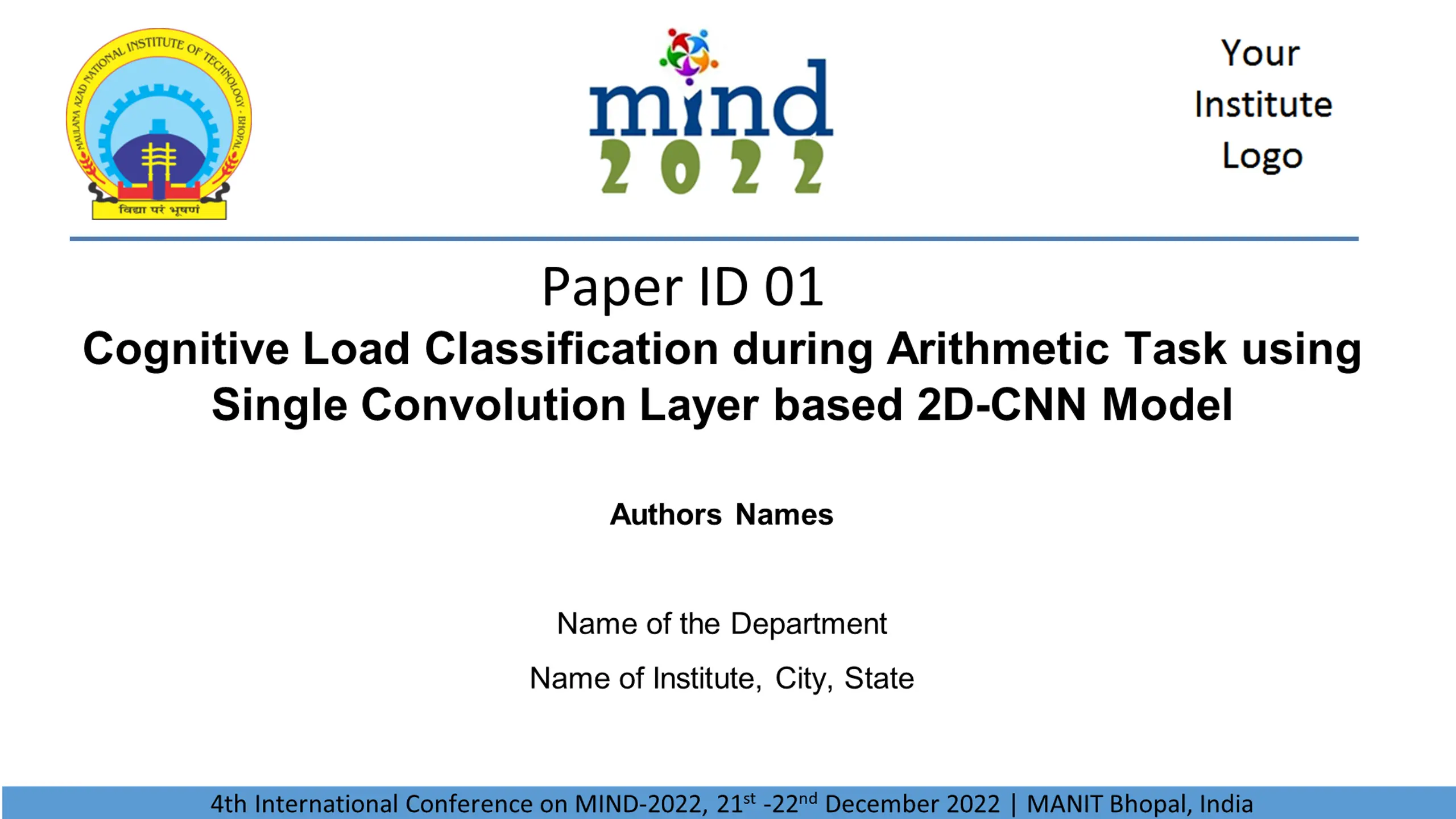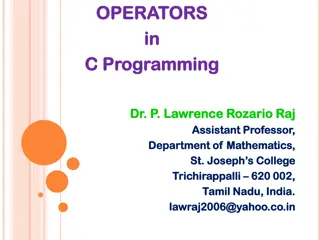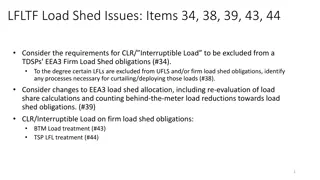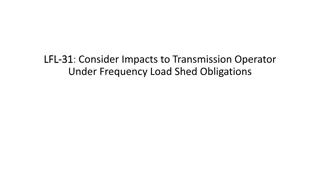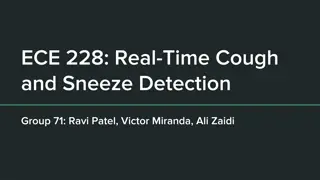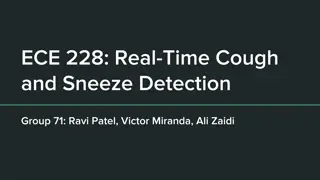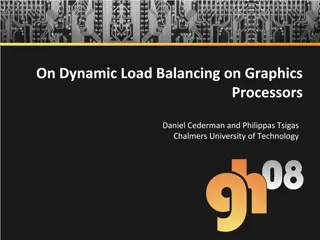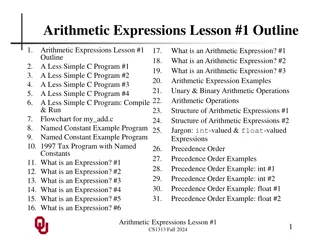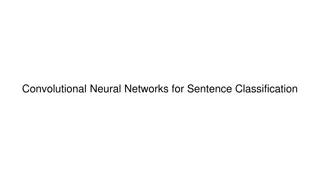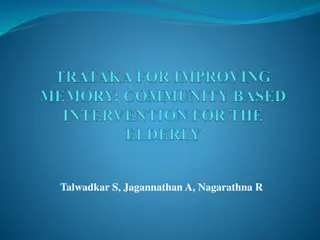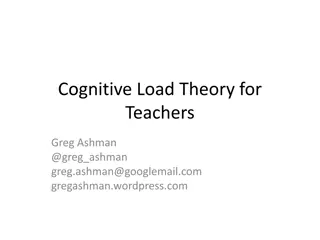Cognitive Load Classification with 2D-CNN Model in Mental Arithmetic Task
Cognitive load is crucial in assessing mental effort in tasks. This paper discusses using EEG signals and a 2D-CNN model to classify cognitive load during mental arithmetic tasks, aiming to optimize performance. EEG signals help evaluate mental workload, although they can be sensitive to noise. The study showcases the benefits of EEG-based cognitive load assessment, especially in times like the ongoing pandemic. By reshaping EEG signals into 2D matrices for CNN processing, this work introduces a novel approach to mental state classification during arithmetic tasks.
Download Presentation

Please find below an Image/Link to download the presentation.
The content on the website is provided AS IS for your information and personal use only. It may not be sold, licensed, or shared on other websites without obtaining consent from the author.If you encounter any issues during the download, it is possible that the publisher has removed the file from their server.
You are allowed to download the files provided on this website for personal or commercial use, subject to the condition that they are used lawfully. All files are the property of their respective owners.
The content on the website is provided AS IS for your information and personal use only. It may not be sold, licensed, or shared on other websites without obtaining consent from the author.
E N D
Presentation Transcript
Paper ID 01 Cognitive Load Classification during Arithmetic Task using Single Convolution Layer based 2D-CNN Model Authors Names Name of the Department Name of Institute, City, State 4th International Conference on MIND-2022, 21st-22ndDecember 2022 | MANIT Bhopal, India
PresentationOutline Introduction Dataset Description CNN Architecture Performance Measures Results and Analysis Conclusion and Future Scope References 4th International Conference on MIND-2022, 21st-22ndDecember 2022 | MANIT Bhopal, India
Introduction Cognitive load (CL) also called Mental Workload (MWL) is the quantitative measure of mental effort required to complete a task [1]. It is used in many fields like driver health assessment, educational program review, mental state analysis of airplane dispatchers and pilots [2]. An optimal CL is required for better performance and if it exceeds a certain limit it can cause mental fatigue. Mental fatigue causes loss in employee performance and for finding an optimal CL some assessment or measure for CL is required. Cognitive Load can be measured using various methods [3] like traditional manual questionnaire process, physiological signals like electroencephalogram (EEG) [4], electrocardiogram (ECG), galvanic responses [5], and eye movement tracking [6]. 4th International Conference on MIND-2022, 21st-22ndDecember 2022 | MANIT Bhopal, India
Introduction EEG signals are used to measure the activity of the brain due to change in electrical voltage because of synaptic excitations of dendrites. EEG signals are classified into 5 categories based on their frequency band. CL can be measure through EEG and it is also the cheapest way. But EEG has some limitations of its own as it easily gets affected by artifacts/ noises. These artifacts can be removed from the signal using various signal processing and filtering methods [8-10]. Many studies have been done for MWL assessment using EEG signals. CL assessment is used for evaluating multimedia resources for education [11]. It is highly beneficial especially in the time of pandemic when the mental health is of utmost importance. 4th International Conference on MIND-2022, 21st-22ndDecember 2022 | MANIT Bhopal, India
Introduction MWL assessment is very importance for society and it is also related to almost all the tasks which engages brain [14-15] like emotion detection [16-17], mental stress identification [18-19] At present the recent trend of research is the use of CNN and other deep learning models to solve classification problems. Therefore, in this paper an attempt has been done to classify mental state of subject based on their CL while performing mental arithmetic task. Novelty of this paper is that, for the first time 2D-CNN model is utilized on the EEG dataset of mental arithmetic calculations. For this one dimensional EEG signal is reshaped into two dimensional matrix as input to 2D-CNN. EEG dataset which has data for mental arithmetic task is used [7]. During recording of EEG signals, subjects are performing series of subtractions in their brain (mentally). The subjects performing this task were labelled as Good Counter (GC) and Bad Counter (BC) based on the accuracy of result of subtraction. Two Dimensional Convolutional Neural Network (2D-CNN) model is used for classification of GC and BC, input to CNN is EEG signal. 4th International Conference on MIND-2022, 21st-22ndDecember 2022 | MANIT Bhopal, India
Dataset Description The dataset comprises 36 recording of multichannel EEG corresponding to 36 subjects at the time of mental arithmetic task. Out of 36 subjects, 26 are Good Counter and 10 are Bad Counter. The EEG signal is recorded with the help of a device named Neurocom Monopolar EEG 23-channel system. The EEG signals are recorded for 61 seconds with a sampling frequency of 500 Hz The shape of the matrix for a single subject is 19*31000. The shape of the matrix is reshaped. The new shape of the matrix is 760*775 where each channel s signal is divided into 40 equal parts and arranged consecutively to form the new shape. This is done to make shape of the matrix symmetric 4th International Conference on MIND-2022, 21st-22ndDecember 2022 | MANIT Bhopal, India
CNN Architecture Fig. 1. The Architecture of the CNN used for Classification 4th International Conference on MIND-2022, 21st-22ndDecember 2022 | MANIT Bhopal, India
Performance Measures There are different performance measures used to compare the different architectures of CNN, such as Accuracy, Precision, Recall, Area Under Curve, and F1- score. (i) Accuracy (ACC): ACC = (TP + TN) / (TP + TN + FP + FN), (1) (ii) Precision (PR)/ (Positive Predictive Value (PPV)): TPR = TP / (TP + FP), (2) 4th International Conference on MIND-2022, 21st-22ndDecember 2022 | MANIT Bhopal, India
Performance Measures (iii) Recall (RC) or Sensitivity: RC = TP / (FN + TP), (3) (iv) F1 Score: F1 = 2 * ((PR * RC) / (PR + RC)), (4) 4th International Conference on MIND-2022, 21st-22ndDecember 2022 | MANIT Bhopal, India
Results and Analysis Table 1. Performance Measures for numbers of filters 32 in the architecture Stride Size Accuracy Precision Recall AUC F1-score 94.44% 96.15% 96.15% 93.07% 96.15% 1 2 88.88% 100.00% 84.61% 92.30% 91.66% 86.11% 95.65% 84.61% 88.84% 89.79% 3 94.44% 92.85% 100.00% 94.61% 96.29% 4 4th International Conference on MIND-2022, 21st-22ndDecember 2022 | MANIT Bhopal, India
Results and Analysis Table 2. Performance Measures for numbers of filters 16 in the architecture Stride Size Accuracy Precision Recall AUC F1-score 94.44% 96.15% 96.15% 93.07% 96.15% 1 2 97.22% 96.29% 100.00% 94.80% 98.11% 88.88% 100.00% 84.61% 91.53% 91.66% 3 94.44% 96.15% 96.15% 92.88% 96.15% 4 4th International Conference on MIND-2022, 21st-22ndDecember 2022 | MANIT Bhopal, India
Results and Analysis Table 3. Performance Measures for numbers of filters 8 in the architecture Stride Size Accuracy Precision Recall AUC F1-score 88.88% 100.00% 84.61% 92.30% 91.66% 1 94.44% 96.15% 96.15% 94.80% 96.15% 2 94.44% 96.15% 96.15% 94.61% 96.15% 3 94.44% 96.15% 96.15% 94.23% 96.15% 4 4th International Conference on MIND-2022, 21st-22ndDecember 2022 | MANIT Bhopal, India
Results and Analysis Table 4. Results of Leave-one-subject-out validation for 16 filters and stride size 2 Stride Size Accuracy Precision Recall F1-score 2 94.44% 72.22% 72.22% 72.22% 4th International Conference on MIND-2022, 21st-22ndDecember 2022 | MANIT Bhopal, India
Results and Analysis Fig. 2. Average Performance Measures for different numbers of filters 4th International Conference on MIND-2022, 21st-22ndDecember 2022 | MANIT Bhopal, India
Conclusion and Future Scope In this study, a single convolution layer based 2D-CNN architecture is used to classify total 36 subjects into Good counter and Bad counter based on the EEG signals recorded during mental task. The various parameters of CNN like no. of filters, kernel size, and stride length are varied to find the optimum architecture which gives the best performance. The best accuracy of 97.22% is achieved for kernel size 3, no. of filters 16, and stride size 2 when using hold-out validation. The same architecture when used with leave-one-subject-out validation gives accuracy of 94.44%. In future this work will be extended using data augmentation techniques for generating new data samples in order to make number of samples balanced in both the classes. 4th International Conference on MIND-2022, 21st-22ndDecember 2022 | MANIT Bhopal, India
References 1. effects of task difficulty, type of processing, and practice. Cerebral Cortex, 7(4), pp.374-385. Gevins, A., 1997. High-resolution EEG mapping of cortical activation related to working memory: 2. Classification of Cognitive Workload Based on EEG Spectral Data. Applied Sciences, 9(24), p.5340. Plechawska-W jcik, M., Tokovarov, M., Kaczorowska, M. and Zapa a, D., 2019. A ThreeClass 3. as a means to advance cognitive load theory. Educational Psychologist, 38, 63 72. Paas, F., Tuovinen, J., Tabbers, H., & Van Gerven, P. W. M., 2003, Cognitive load measurement 4. Cognitive Load. EducPsychol Rev 22, 425 438. Antonenko, P., Paas, F., Grabner, R. et al., 2010, Using Electroencephalography to Measure 5. Tasks, 2019 4th International Conference on Electrical Information and Communication Technology (EICT), Khulna, Bangladesh, pp. 1-4. D. Hossain et al.,2019, Cognitive Load Measurement Using Galvanic Skin Response for Listening 4th International Conference on MIND-2022, 21st-22ndDecember 2022 | MANIT Bhopal, India
References 6. exploratory study of young children, 2019 IEEE Conference on Games (CoG), London, United Kingdom, pp. 1-6. A. Fowler, K. Nesbitt and A. Canossa,2019,Identifying Cognitive Load in a Computer Game: An 7. Electroencephalograms during Mental Arithmetic Task Performance. Data, 4(1), p.14 Zyma, I., Tukaev, S., Seleznov, I., Kiyono, K., Popov, A., Chernykh, M. and Shpenkov, O., 2019. 8. International Conference on Frontiers of Intelligent Computing: Theory and Applications (FICTA), NIT Karnataka, Surathkal, India, Jan 2020 (In Press). M. K. Ahirwal, 2020, Analysis and Identification of EEG Features for MentalStress, In 8th 9. Controlled Search Space (CSS) Approach in Cuckoo and Other Optimization Algorithms, IEEE/ACM Transactions on Computational Biology and Bioinformatics, vol. 10, no. 6, pp. 1491-1504. M. K. Ahirwal, A. Kumar and G. K. Singh, 2013, EEG/ERP Adaptive Noise Canceller Design with 10. adaptive noise canceller for EEG/ERP, International Journal of Bio-Inspired Computation, Vol. 8, No. 3, 2016, pp. 170-183. 4th International Conference on MIND-2022, 21st-22ndDecember 2022 | MANIT Bhopal, India M. K. Ahirwal, A. Kumar, and G. K. Singh, 2016, Study of ABC and PSO algorithms as optimized
References 11. Learning, 2010 Second International Conference on Multimedia and Information Technology, Kaifeng, pp. 14-16. B. Wang, F. Wu and S. Zhang, 2010, Reflections on the Control of Cognitive Load in Multimedia 12. Multitasking in the Car, 20th International Conference on Pattern Recognition, Istanbul, pp. 3748-3751 F. Putze, J. Jarvis and T. Schultz, 2010,Multimodal Recognition of Cognitive Workload for 13. Signals. Frontiers in Computational Neuroscience, 11. Hu, J., 2017. Automated Detection of Driver Fatigue Based on AdaBoost Classifier with EEG 14. driver's cognitive mental load, IEEE 10th International Conference on Cognitive Informatics and Cognitive Computing (ICCI-CC'11), Banff, AB, pp. 67-74. S. Sega, H. Iwasaki, H. Hiraishi and F. Mizoguchi, 2011,Applying qualitative reasoning to a 15. Classification during Mental Arithmetic Task, ADCOM 2020 : 26th annual International Conference on Advanced Computing and Communications (In Press). Aman Anand Rai, Mitul Kumar Ahirwal, 2020, Electroencephalogram based Cognitive Load 4th International Conference on MIND-2022, 21st-22ndDecember 2022 | MANIT Bhopal, India
References 16. correlated EEG channels. Health and Technology, 10(1), 7-23. Ahirwal, M. K., & Kose, M. R. (2020). Audio-visual stimulation based emotion classification by 17. Signals. In: Bhateja V., Peng SL., Satapathy S.C., Zhang YD. (eds) Evolution in Computational Intelligence. Advances in Intelligent Systems and Computing, vol 1176. Springer, Singapore. https://doi.org/10.1007/978- 981-15-5788-0_27 Ahirwal M.K., Kose M.R. (2021) Development of Emotional Decision-Making Model Using EEG 18. Peng SL., Satapathy S.C., Zhang YD. (eds) Evolution in Computational Intelligence. Advances in Intelligent Systems and Computing, vol 1176. Springer, Singapore. https://doi.org/10.1007/978-981-15-5788-0_19 Ahirwal M.K. (2021) Analysis and Identification of EEG Features for Mental Stress. In: Bhateja V., 19. Biomedical Signal Processing. SpringerBriefs in Electrical and Computer Engineering. Springer, Cham. https://doi.org/10.1007/978-3-030-67098-6_1 Ahirwal M.K., Kumar A., Singh G.K. (2021) Biomedical Signals. In: Computational Intelligence and 20. classification tasks: a review. Journal of neural engineering, 16(3), 031001 Craik, A., He, Y., & Contreras-Vidal, J. L. (2019). Deep learning for electroencephalogram (EEG) 4th International Conference on MIND-2022, 21st-22ndDecember 2022 | MANIT Bhopal, India
